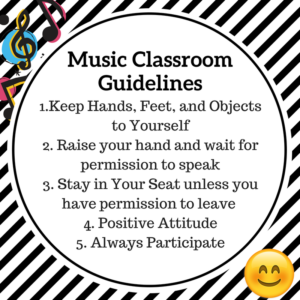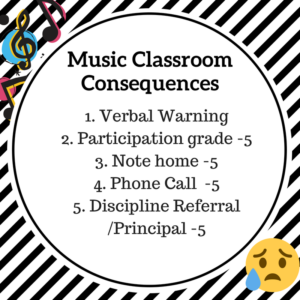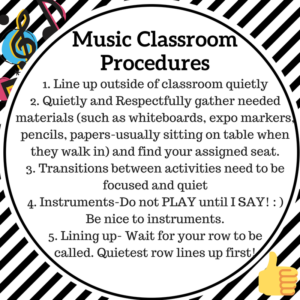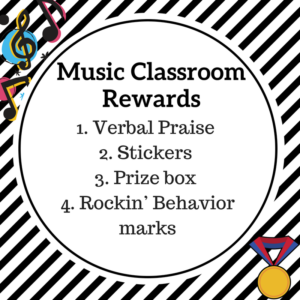Alright, friends. Brace yourselves. The school year is coming back in a few weeks whether we like it or not! I always find that it’s best to start preparing my mind, heart and body a few weeks before school starts. At this time of July, I start trying to wake up earlier, plan out my morning routine, think through some lesson ideas, and order some needed materials. By slowly easing into my routine, and gradually switching my mindset, it usually helps ease the shock of getting back into the swing of things.
So in order to help you ease your mind, heart and body back into the school year, I will be writing a series of 4 “Back to School” posts between now and the end of August. The first post will be about Classroom Management tips, Guidelines, and Procedures that I use often in my classroom. I’m wanting to post about this because many of the fun and effective strategies for homeroom teachers, that have 30 or less students a day, don’t work for the Specials Teachers (Music, Art, PE) who see the entire student body during the span of one week. In order to survive, Specials Teachers need management strategies that are quick, effective, and sustainable. So here are some of my simple yet effective tips for keeping peace and sanity in the music classroom.
- Behavioral Narration:
Overall, I recommend using Positive Reinforcement techniques for classroom management. I specifically use a method called “Behavioral Narration”. When I started incorporating this technique, it was a classroom management game-changer!!! Behavior Narration is simply when the teacher points out a student who is already exhibiting the desired behavior. This draws attention to the students who are following directions, instead of drawing attention students who are not meeting expectations.
For example. Say you want your students to turn to page 14 in their textbooks. Most of the students follow directions, except one student who is off-task. I think a lot of people’s first instinct would be to call out the off-task students by saying something like, “Johnny-you better turn to page 14 right now”, or “Johnny-you need to stay on task!”. But behavioral narration is simply narrating the behavior of a student near them who IS on task. So maybe Darren sits right next to Johnny and has already followed directions. You would simply say something like, “I see that Darren has turned to page 14 in his book”. Usually Johnny will straighten up and start turning his book to page 14. But if that doesn’t work, point out ANOTHER student who is on task, “I see that Sara has turned to page 14 in her book.”
All you have to do is calmy state the student’s name and their positive behavior. In my experience, this works about 9/10 times! It allows me to stay calm, positive, restate my expectations, and it changes my overall mindset. It’s important to not give attention to students when they are off-task, because some of those students are craving that attention, and will continue whatever behavior is getting them this attention. So, right when they display the desired behavior, be sure to pay attention. “I see that Johnny turned to page 14!”. This also works in groups. For the seating arrangement in my classroom, I divide my students into rows with colors. If I’m wanting them to stay quiet, I might call out the quietest row first by saying, “The purple row is following directions and they are quiet”. I guarantee that you will see the other rows straightening up and trying to be on task.
- Rockin’ Behavior System
I created this “Rockin’ Behavior” chart to use with my classroom management system for Kindergarten through 5th grade. We currently have 5 sections for each grade-A, B, C, D and E.
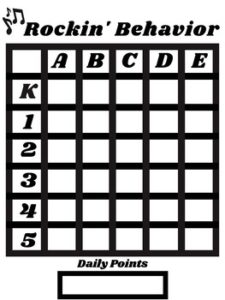
If the class is all following directions and on-task as a group (especially during transitions from one activity to the next), I congratulate them and put a tally mark in the “Daily Points” box. Once the box gets to 5 tally marks, then they get a sticker in the chart. If their class is “1A”, I put one sticker in that box. If their class gets to six stickers in the chart (correlates with six week grading periods), then the class gets a “shoutout” on the morning announcements as the “Music Class of the Month”, and they get 15 minutes of free time at the end of the next class period. You could also take a picture of that class and feature them on your outside bulletin board. I like this system because the classes get competitive with one another and they like to work together to get points. It is also positive reinforcement and rewards students for teamwork and positive behavior. This poster is available on my Teachers Pay Teachers store!
3. Post your Classroom Guidelines/Consequences and be consistent from Day 1!
Make sure your classroom guidelines, consequences, and rewards are posted in the front of the classroom, with text large enough for all students to see. Go over them in class on THE FIRST DAY, and enforce the consequences if needed. Make sure students know you are consistent and fair with these rules, or else they will disregard them. You may need to briefly go over them again at the beginning of class for the first few weeks just to keep the rules fresh in their mind! Just to give you an example, here are the Guidelines/Consequences/Rewards/Procedures that I post in my room:
Resources:
My favorite dollar tree stickers
4. Attention-Getters.
Attention-Getters are a great way to quickly gather the attention of your classroom. Here are some of my favorites that have been extremely effective for me!
-
- Holey Moley- GUACAMOLE
-
- Hocus Pocus- EVERYBODY FOCUS
-
- Clap a rhythm-they clap it back (such as: ta, ta, ti-ti, ta)
-
- Give me 5! (Hold up hand)
-
- If you can hear my voice clap once, if you can hear my voice clap twice…and so on
- 1-2-3, eyes on me- 1, 2, eyes on you on
I hope you can benefit from these Classroom Management strategies and find peace and sanity in your classroom this year!
Have a great day!
-Paige-
